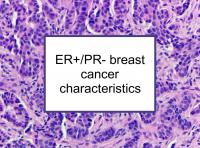Approximately 10% of U.S. invasive breast cancers are classified as estrogen receptor positive and progesterone receptor negative, or ER+/PR-. In other words, the cancer cells express estrogen receptors, but not progesterone receptors. This type of breast cancer is somewhat more likely to be HER2+ than ER-/PR- breast cancer.
Women with ER+/PR- breast cancer are more likely to be postmenopausal than most other types — the average age at diagnosis is approximately 65 years. They are also somewhat more likely to be Asian American.
Compounds that regulate ER or PR expression, oppose the production of estrogen in the body (i.e., oppose aromatase) or inhibit estrogen binding to estrogen receptors are among those used to treat this type of breast cancer. Tumors with a large number of estrogen receptors are associated with a better prognosis than those with few.
The significance of a lack progesterone receptors in the presence of estrogen receptors is not well understood, leading some observers and clinicians to regard this subtype as very similar to hormone receptor positive (ER+/PR+) breast cancer. However, there do appear to be some differences. Lack of PR expression in ER+/PR- tumors may be a marker of aberrant growth factor signaling that could contribute to the tamoxifen resistance observed in these tumors. Less favorable prognosis has been reported for ER+/PR- compared to ER+/PR+ breast cancer, especially when ER+/PR- tumors demonstrate high proliferation (Ki-67).
ER+/PR- breast cancer patients may benefit from EGFR inhibitors
As noted above, ER+/PR- breast cancer has a lower response rate to estrogen deprivation and a worse prognosis compared to ER+/PR+ disease, indicating that it may be dependent on other signaling pathways. In fact, ER+/PR- disease was shown to be growth factor-dependent in one study, and therefore likely to benefit from epidermal growth factor receptor (EGFR) inhibition.
HRT and dense breasts increase risk of ER+/PR- type
Both estrogen only and estrogen-progestin combined hormone replacement therapy (HRT) have been found to be associated with increased risk of ER+/PR- breast cancer. Women with high breast density have an increased risk of breast cancer, including ER+/PR- tumors.
Serotonin reuptake inhibitors (SSRIs) may increase risk of ER+/PR-
Serotonin has a role in normal mammary gland development, where it helps to regulate lactation and involution (the shrinkage of the milk-production apparatus when it is not needed). Excess serotonin is made in breast cancer cells, where it functions improperly, contributing to malignant growth and inhibiting appropriate cell death. Use of antidepressants classified as selective serotonin reuptake inhibitors (SSRIs) such as Paxil and Prozac are suspected of increasing risk of ER+/PR- breast cancer in older women.
Additional comments
Please see our article on diet for ER+/PR- breast cancer for information on food, supplements and over-the-counter medications.
Below are links to 20 studies concerning this topic.
